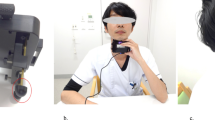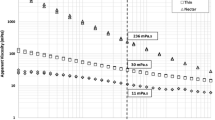Abstract
Considering that thickened liquids are frequently used for patients with dysphagia, elucidating their impact on laryngeal dynamics is important. Although studies have investigated the impact of thickened liquids on laryngeal movement velocity among healthy young adults, no study has examined the same among patients with dysphagia. We aimed to elucidate the influence of bolus consistency on laryngeal movement velocity and surface electromyographic activity of the suprahyoid muscles in patients with dysphagia. Participants included 18 male, poststroke patients with dysphagia, whereas patients with true bulbar paralysis, head and neck cancer, neuromuscular disease, or recurrent nerve paralysis were excluded. A video fluoroscopic swallowing study (VFSS) was performed while swallowing 3 mL of moderately thick and thin liquids. Quantitative VFSS analysis, including factors such as laryngeal peak velocity, laryngeal mean velocity, laryngeal movement distance, duration of the laryngeal elevation movement, and the temporal location of laryngeal vestibule closure within the laryngeal elevation movement was performed. Muscle activity was evaluated using integrated muscles activity values obtained from electromyography (iEMG) of the suprahyoid muscle during swallowing. VFSS analysis showed that laryngeal peak velocity and laryngeal mean velocity were significantly faster while swallowing moderately thick than while swallowing thin liquids. Laryngeal movement distance was significantly greater while swallowing moderately thick than while swallowing thin liquids. iEMG was significantly higher while swallowing moderately thick liquids than while swallowing thin liquids. Compared to thin liquids, moderately thick induced an increase in laryngeal movement velocity and in suprahyoid muscle activity among patients with dysphagia, a finding consistent with that of a previous study among healthy adults.



Similar content being viewed by others
References
Robbins J, Nicosia M, Hind JA, Gill GD, Blanco R, Logemann J. Defining physical properties of fluids for dysphagia evaluation and treatment. Perspect Swallow Swallow Disorders (Dysphagia). 2002;11(2):16–9. https://doi.org/10.1044/sasd11.2.16.
Cichero JA. Thickening agents used for dysphagia management: effect on bioavailability of water, medication and feelings of satiety. Nutr J. 2013;12:54. https://doi.org/10.1186/1475-2891-12-54.
Bisch EM, Logemann JA, Rademaker AW, Kahrilas PJ, Lazarus CL. Pharyngeal effects of bolus volume, viscosity, and temperature in patients with dysphagia resulting from neurologic impairment and in normal subjects. J Speech Hear Res. 1994;37(5):1041–59. https://doi.org/10.1044/jshr.3705.1041.
Dantas RO, Kern MK, Massey BT, Dodds WJ, Kahrilas PJ, Brasseur JG, Cook IJ, Lang IM. Effect of swallowed bolus variables on oral and pharyngeal phases of swallowing. Am J Physiol. 1990;258(5 Pt 1):G675-681. https://doi.org/10.1152/ajpgi.1990.258.5.G675.
Kuhlemeier KV, Palmer JB, Rosenberg D. Effect of liquid bolus consistency and delivery method on aspiration and pharyngeal retention in dysphagia patients. Dysphagia. 2001;16(2):119–22. https://doi.org/10.1007/s004550011003.
Trent A, Park T, Oommen E, Kim Y. The effects of bolus consistencies on the swallowing safety in poststroke patients. Commun Sci Disorders. 2014;19(2):249–55. https://doi.org/10.12963/csd.14129.
Sura L, Madhavan A, Carnaby G, Crary MA. Dysphagia in the elderly: management and nutritional considerations. Clin Interv Aging. 2012;7:287–98. https://doi.org/10.2147/CIA.S23404.
Zu Y, Yang Z, Perlman AL. Hyoid displacement in post-treatment cancer patients: preliminary findings. J Speech, Language, and Hear Res. 2011;54(3):813–20. https://doi.org/10.1044/1092-4388(2010/10-0077).
Ishida R, Palmer JB, Hiiemae KM. Hyoid motion during swallowing: factors affecting forward and upward displacement. Dysphagia. 2002;17(4):262–72. https://doi.org/10.1007/s00455-002-0064-5.
Rofes L, Arreola V, Mukherjee R, Swanson J, Clave P. The effects of a xanthan gum-based thickener on the swallowing function of patients with dysphagia. Aliment Pharmacol Ther. 2014;39(10):1169–79. https://doi.org/10.1111/apt.12696.
Oommen ER, Kim Y, McCullough G. Stage transition and laryngeal closure in poststroke patients with dysphagia. Dysphagia. 2011;26(3):318–23. https://doi.org/10.1007/s00455-010-9314-0.
Lee SI, Yoo JY, Kim M, Ryu JS. Changes of timing variables in swallowing of boluses with different viscosities in patients with dysphagia. Arch Phys Med Rehabil. 2013;94(1):120–6. https://doi.org/10.1016/j.apmr.2012.07.016.
Lin PH, Hsiao TY, Chang YC, Ting LL, Chen WS, Chen SC, Wang TG. Effects of functional electrical stimulation on dysphagia caused by radiation therapy in patients with nasopharyngeal carcinoma. Support Care Cancer. 2011;19(1):91–9. https://doi.org/10.1007/s00520-009-0792-2.
Nagy A, Molfenter SM, Peladeau-Pigeon M, Stokely S, Steele CM. The effect of bolus consistency on hyoid velocity in healthy swallowing. Dysphagia. 2015;30(4):445–51. https://doi.org/10.1007/s00455-015-9621-6.
Nakao Y, Onishi H, Haji T, Shiromoto O, Fukuoka T, Saito S, Tabe Y, Kodama N, Domen K. A quantitative analysis of the laryngeal moving velocity during swallowing: the effect of bolus viscosity on laryngeal movement in healthy males. Deglutit: Off J Soc Swallow Dysphagia Japan. 2017;6(1):79–85.
Park J, Yoo W, Yoo B. Standard recipes for the preparation of thickened barium liquids used in the diagnosis of Dysphagia. Clin Nutr Res. 2019;8(4):265–71. https://doi.org/10.7762/cnr.2019.8.4.265.
Molfenter SM, Steele CM. Use of an anatomical scalar to control for sex-based size differences in measures of hyoid excursion during swallowing. J Speech Lang Hear Res. 2014;57(3):768–78. https://doi.org/10.1044/2014_JSLHR-S-13-0152.
Ueda N, Nohara K, Kotani Y, Tanaka N, Okuno K, Sakai T. Effects of the bolus volume on hyoid movements in normal individuals. J Oral Rehabil. 2013;40(7):491–9. https://doi.org/10.1111/joor.12060.
Nagy A, Molfenter SM, Peladeau-Pigeon M, Stokely S, Steele CM. The effect of bolus volume on hyoid kinematics in healthy swallowing. Biomed Res Int. 2014;2014:738971. https://doi.org/10.1155/2014/738971.
Rosenbek JC, Robbins JA, Roecker EB, Coyle JL, Wood JL. A penetration-aspiration scale. Dysphagia. 1996;11(2):93–8. https://doi.org/10.1007/BF00417897.
Pearson WG Jr, Molfenter SM, Smith ZM, Steele CM. Image-based measurement of post-swallow residue: the normalized residue ratio scale. Dysphagia. 2013;28(2):167–77. https://doi.org/10.1007/s00455-012-9426-9.
Inamoto Y, Saitoh E, Okada S, Kagaya H, Shibata S, Ota K, Baba M, Fujii N, Katada K, Wattanapan P, Palmer JB. The effect of bolus viscosity on laryngeal closure in swallowing: kinematic analysis using 320-row area detector CT. Dysphagia. 2013;28(1):33–42. https://doi.org/10.1007/s00455-012-9410-4.
Raut VV, McKee GJ, Johnston BT. Effect of bolus consistency on swallowing–does altering consistency help? Eur Arch Otorhinolaryngol. 2001;258(1):49–53. https://doi.org/10.1007/s004050000301.
Sia I, Crary MA, Kairalla J, Carnaby GD, Sheplak M, McCulloch T. Bolus volume and viscosity effects on pharyngeal swallowing power-How physiological bolus accommodation affects bolus dynamics. Neurogastroenterol Motil. 2018;30(12):e13481. https://doi.org/10.1111/nmo.13481.
Reimers-Neils L, Logemann J, Larson C. Viscosity effects on EMG activity in normal swallow. Dysphagia. 1994;9(2):101–6. https://doi.org/10.1007/bf00714596.
Taniguchi H, Tsukada T, Ootaki S, Yamada Y. Inoue M (2008) Correspondence between food consistency and suprahyoid muscle activity, tongue pressure, and bolus transit times during the oropharyngeal phase of swallowing. J Appl Physiol. 1985;105(3):791–9. https://doi.org/10.1152/japplphysiol.90485.2008.
Zhu M, Yu B, Yang W, Jiang Y, Lu L, Huang Z, Chen S, Li G. Evaluation of normal swallowing functions by using dynamic high-density surface electromyography maps. Biomed Eng Online. 2017;16(1):133. https://doi.org/10.1186/s12938-017-0424-x.
Wu S, Chu L, Liu CF, Zhang Q, Zhang YF, Zhou TF, Wang ZT, Ni RH, Li Y. Effect of Changes in Bolus Viscosity on Swallowing Muscles in Patients with Dysphagia after Stroke. Chin Med J (Engl). 2018;131(23):2868–70. https://doi.org/10.4103/0366-6999.246071.
Pearson WG Jr, Davidoff AA, Smith ZM, Adams DE, Langmore SE. Impaired swallowing mechanics of post radiation therapy head and neck cancer patients: A retrospective videofluoroscopic study. World J Radiol. 2016;8(2):192–9. https://doi.org/10.4329/wjr.v8.i2.192.
Steele CM, Alsanei WA, Ayanikalath S, Barbon CE, Chen J, Cichero JA, Coutts K, Dantas RO, Duivestein J, Giosa L, Hanson B, Lam P, Lecko C, Leigh C, Nagy A, Namasivayam AM, Nascimento WV, Odendaal I, Smith CH, Wang H. The influence of food texture and liquid consistency modification on swallowing physiology and function: a systematic review. Dysphagia. 2015;30(1):2–26. https://doi.org/10.1007/s00455-014-9578-x.
Steele CM, Peladeau-Pigeon M, Barbon CAE, Guida BT, Namasivayam-MacDonald AM, Nascimento WV, Smaoui S, Tapson MS, Valenzano TJ, Waito AA, Wolkin TS. Reference Values for Healthy Swallowing Across the Range From Thin to Extremely Thick Liquids. J Speech Lang Hear Res. 2019;62(5):1338–63. https://doi.org/10.1044/2019_JSLHR-S-18-0448.
Acknowledgements
We gratefully acknowledge the work of past and present staffs of the Department of Rehabilitation, Hyogo College of Medicine College Hospital. This study was partly supported by the Japan Society for the Promotion of Science [KAKENHI (19H00462)].
Author information
Authors and Affiliations
Contributions
Conceptualization—YN, HO, TH, OS, and KD. Data curation—YN, SS, TN, and YU. Formal analysis—YN. Funding acquisition—YN. Investigation; Methodology—YN, HO, TH, and OS. Roles/Writing—original draft—YN. Writing—review & editing—YN, HO, TH, OS, YU, and KD.
Corresponding author
Ethics declarations
Conflict of interest
The authors have no conflicts of interest to disclose.
Ethical Approval
This study was approved by the institutional ethics committee of Hyogo College of Medicine. All patients provided their written informed consent before VFSS.
Additional information
Publisher's Note
Springer Nature remains neutral with regard to jurisdictional claims in published maps and institutional affiliations.
Rights and permissions
About this article
Cite this article
Nakao, Y., Onishi, H., Haji, T. et al. Impact of Thickened Liquids on Laryngeal Movement Velocity in Patients with Dysphagia. Dysphagia 37, 207–215 (2022). https://doi.org/10.1007/s00455-021-10267-7
Received:
Accepted:
Published:
Issue Date:
DOI: https://doi.org/10.1007/s00455-021-10267-7




